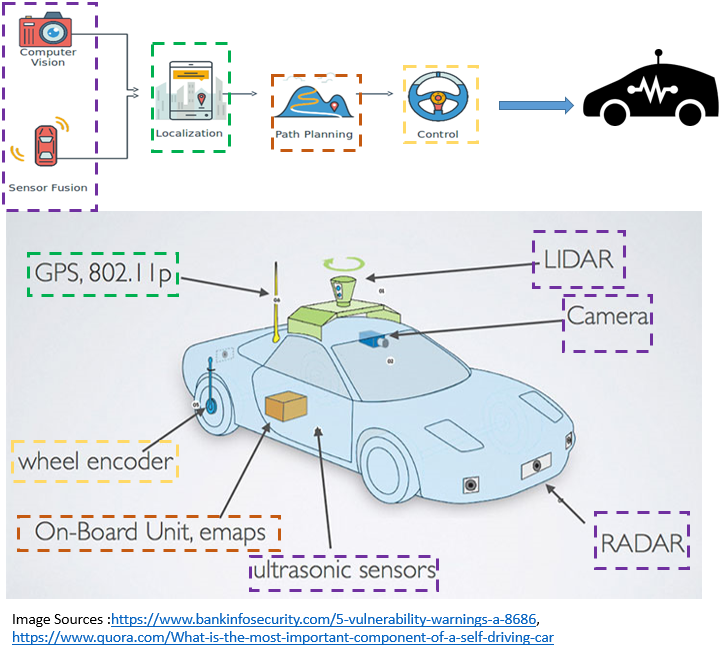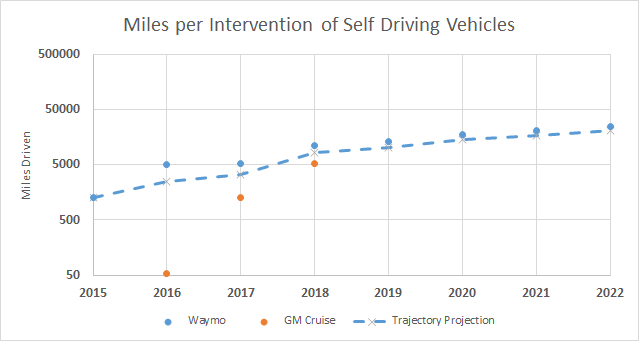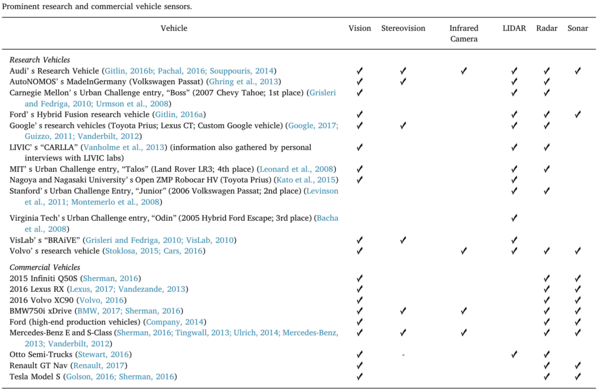Autonomous System for Ground Transport
Technology Roadmap Sections and Deliverables
The first point is that each technology roadmap should have a clear and unique identifier:
- 2ASGT - Autonomous System for Ground Transport
This indicates that we are dealing with a “level 2” roadmap at the product or system level, where “level 1” would indicate a social level roadmap and “level 3” or “level 4” would indicate an individual technology roadmap.
Roadmap Overview
The overview and working principle of autonomous ground transport is depicted below:
Autonomous transport has four main components, namely (1)Perception, (2)Localization, (3)Planning, and (4)Control. The four components work together as depicted in the overview to enable the autonomous capabilities in the transport system.
(1) Perception The data from sensors (radars, lidars, cameras etc) are integrated to build a comprehensive and detailed understanding of the vehicle’s environment
(2) Localization GPS and algorithms are employed to determine the location of the vehicle relative to its surrounding. It is critical for the accuracy to be within the order of centimeters to ensure that the vehicle stay on the road.
(3) Planning With the understanding of the environment and the vehicle's relative location within, a transport route can be planned to get to the desired destination. This involves predicting the behavior of other entities (other vehicles, pedestrians etc) in the immediate proximity followed by deciding the appropriate actions to be taken in response to them. Lastly, a route is developed to reach the destination within required conditions (safety, comfort etc)
(4) Control The planned route is passed onto the vehicle. In this execution phase, the route is translated into control instructions for the vehicle to turn the steering wheel, hit the accelerator or the brake etc.
The autonomous transport technology is intended to bring about improvements in mainly safety and mobility. The number of fatalities in motor incidents are significant each year and autonomous vehicles could potentially reduce that number with the use of software that are less error-prone or less susceptible to distractions than humans. At the same time, autonomous technology can offer mobility to disable or elderly individuals where it is needed the most.
History of Autonomous System for Ground Transport
The first conceptual design was proposed by Leonardo da Vinci in 1478, almost five centuries before pervasive adoption of automobiles. It was technically, however, not the type of autonomous vehicle we refer to at present because the concept focused more on self propelled vehicle with mechanical spring system moving on fixed and predefined routes. We argue that the first ground transport vehicle was the Houdina radio control car built and tested in 1925 as no driver was required to be present in the vehicle itself, despite the fact that the car was indeed remotely controlled by a driver. The major milestones together with their relevant information are listed below.
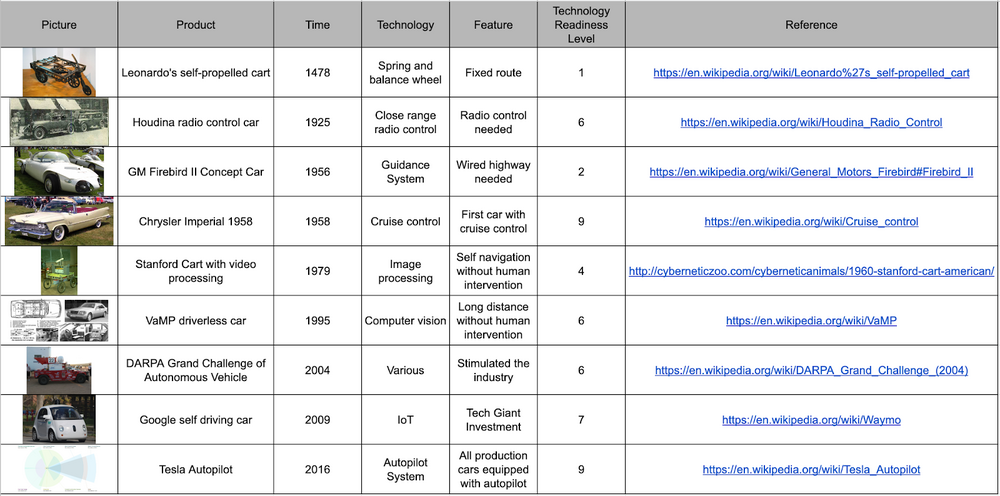
Design Structure Matrix (DSM) Allocation
The autonomous system for ground transport technology sits at level 2 abstraction and is a specification of ground transport at level 1. It can be classified into 5 different level of autonomy. Each level of autonomous system requires a certain number of enabling technologies such as sensors and cameras, which are the level 4 abstraction in the system architecture hierarchy. Going further, it could be insightful for roadmap construction to further decompose the level 4 systems into more specific types of technologies.
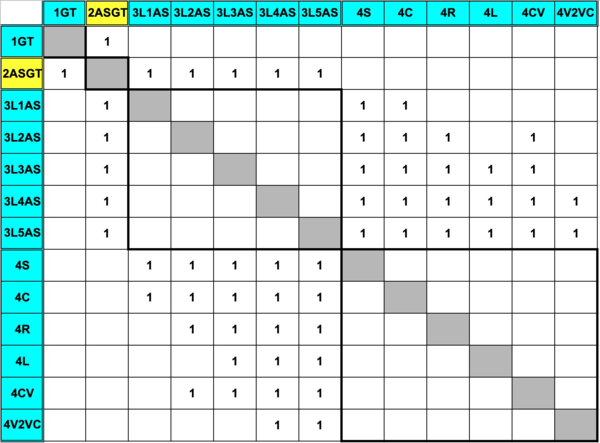
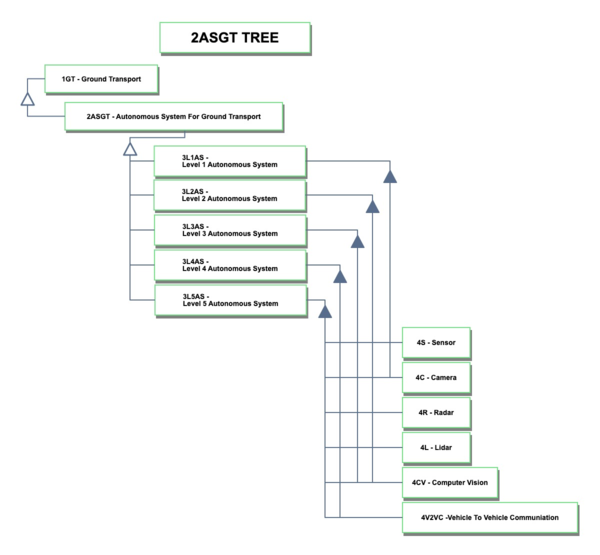 The Object-Process-Language (OPL) description complements the second level autonomous system for ground transport (2ASGT) tree.
The Object-Process-Language (OPL) description complements the second level autonomous system for ground transport (2ASGT) tree.

Roadmap Model using OPM
We provide an Object-Process-Diagram (OPD) of the 2ASGT roadmap in the figure below. This diagram captures the main object of the roadmap (Autonomous System for Ground Transport), its 2-level decomposition into enabling systems (Positioning and Sensing Technologies, Data Storage and Transmission Technologies, Computation and Control Technologies), its characterization by Figures of Merit (FOMs) as well as the main processes and other objects it interacts with.
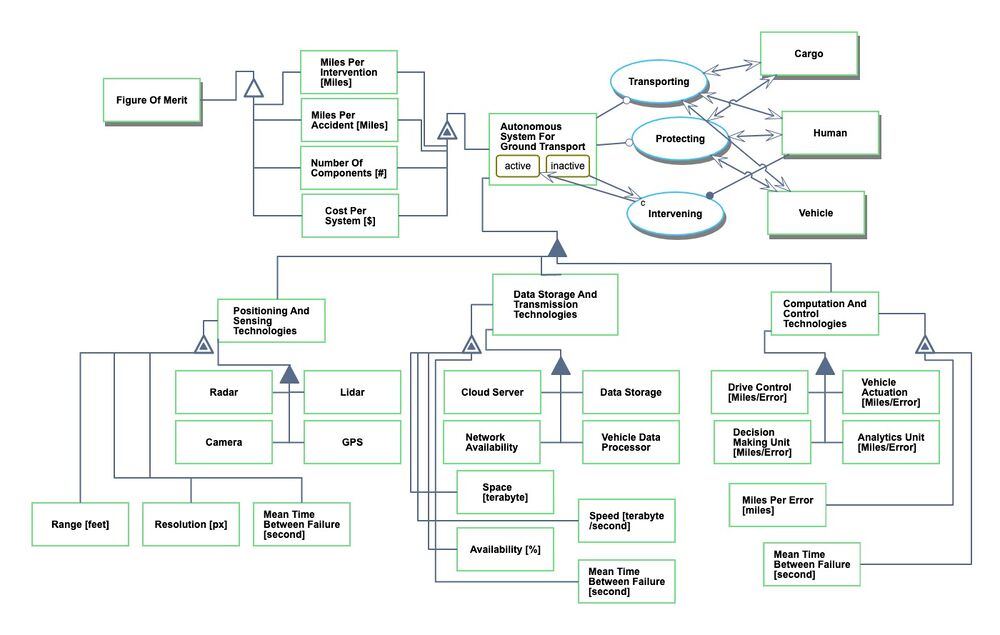
An Object-Process-Language (OPL) description of the roadmap scope is auto-generated and given below. It reflects the same content as the previous figure, but in a formal natural language.
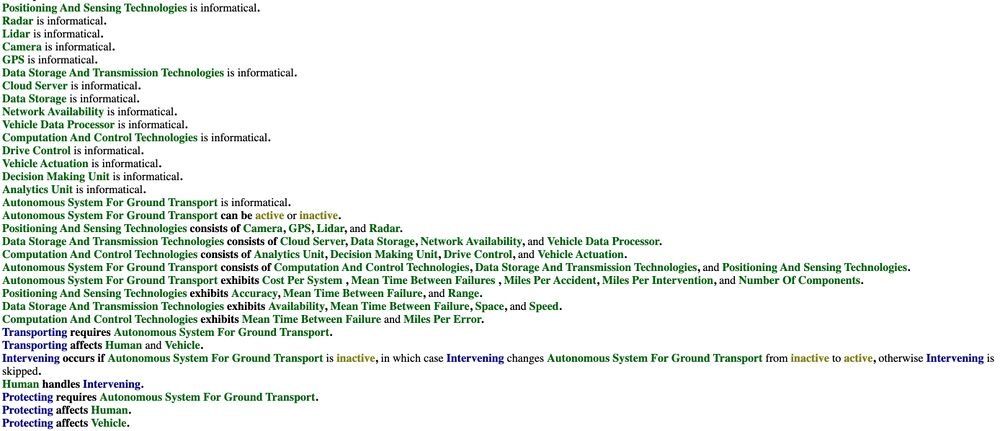
Figures of Merit
Four main figures of merit, in terms of reliability, safety, compatibility, and cost are used to quantify the performance and utility level of the autonomous system for ground transport.
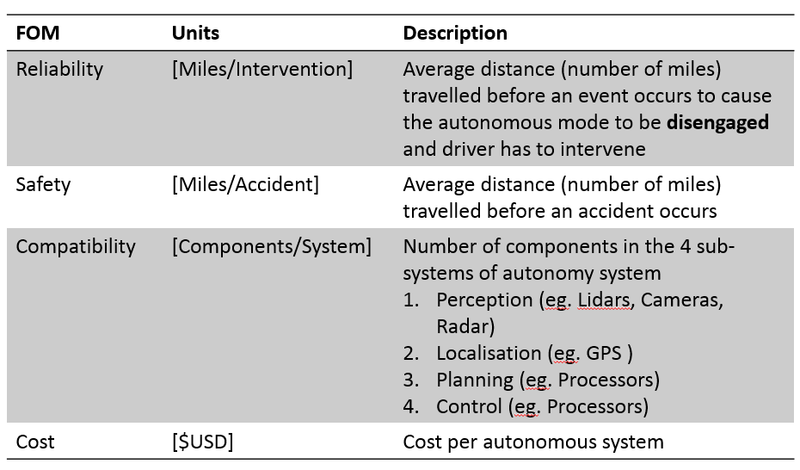
Considering the average logarithmic performance values of the FOM, the average rate of improvement from 2015 to 2016 is about 8% (dFOM/dt).
Alignment with Company Strategic Drivers
The table below shows the potential strategic drivers and their respective alignment with the perception system for autonomous system for ground transport technology roadmap.
Positioning of Company vs. Competition
The Autonomous system for ground transport is a growing industry still in its youth, and like many other technologies, it is an ecosystem that involves various branches and sectors of enabling technologies. Different companies take up their own market share by providing the industries with certain number of forms and/or functions. It is not at all an exaggeration to say that any company in the technology sector has something to do with the autonomy ecosystem.
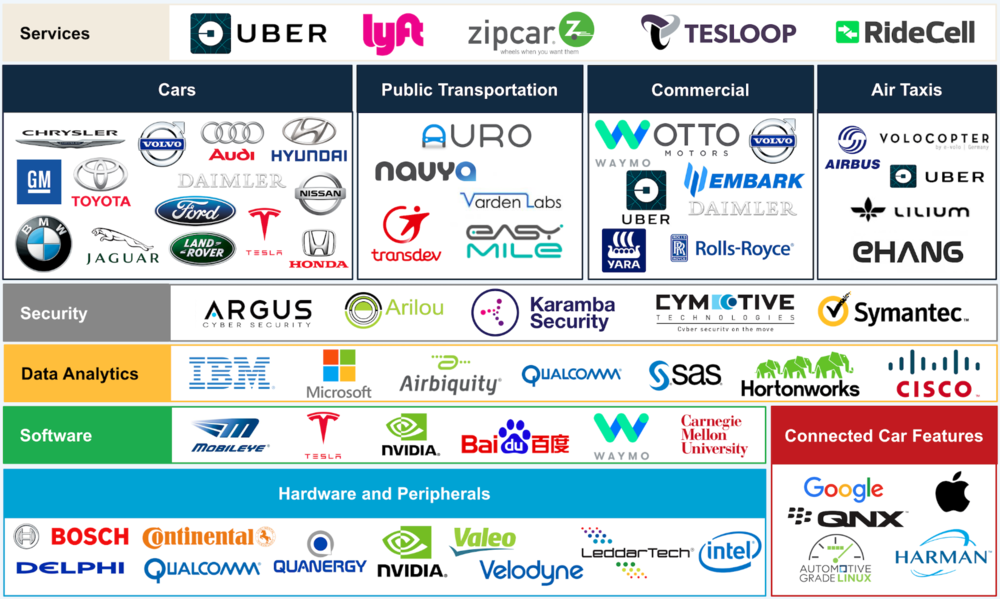
(Source: https://acceleratingbiz.com/proof-point/autonomous-connected-vehicle-ecosystem/)
Within the automobile industry, functions pertaining to autonomous driving have been gradually implemented onto the high end vehicles, as shown in the exhibit below on the left, whose customers are able and willing to pay a premium for these advanced yet developing features. It is a trend that autonomous system would be permeating into a wider range of automobiles especially in trucks, buses, as well as the middle to low end passenger vehicles.
Here we focus on the perception system configurations of products and projects related to autonomous driving development, as presented in the figure below on the right. One observation is that choices regarding types of sensor have been mainly converging into vision, LIDAR, RADAR, and Sonar. This pattern initiated and grounded our technical model construction of the perception system within the autonomous system for ground transport as we concentrate our research and analysis on these four types of sensors.
One drawback of our study on company position and competition, unfortunately, is that most of the autonomous driving technology companies did not publish the parameters and specifications of the sensors they were employing, which makes it difficult to quantify the perception systems available. From a more academic perspective, the majority of publications and research on design and building perception systems were based on either experimental or empirical approaches, making it hard to plot a Pareto front of state of art of the perception systems and their embedded sensor technologies.
Technical Model
Financial Model
List of R&T Projects and Prototypes
Key Publications, Presentations and Patents
The latest three decades witnessed the emergence of autonomous vehicle development. Despite the fact that bias might exist that more recent publication got archived digitally, the number of publications pertaining to autonomous vehicle has been increasing according to the Web of Science database as shown in the exhibit below.

We performed a search for publications and patents relevant to the perception system on the autonomous system for ground transport. These research serve as technological guidance and approach reference for our technology roadmap.
Publications:
Title: Autonomous driving in urban environments: Boss and the Urban Challenge
URL: https://onlinelibrary.wiley.com/doi/abs/10.1002/rob.20255
Key Words: Motion Planning, Perception, Mission Planning, Behavioral Reasoning
Description: This journal paper introduces a three-layer autonomous driving planning system using an autonomous vehicle called Boss, which won the 2007 DARPA Urban Challenge, as an example. Its autonomous system on board comprises of mission, behavior, and motion planning systems. The paper presents the mathematical foundation as well as the development process for the autonomous system that could be generally applied to other similar systems.
Title: Are we ready for autonomous driving? The KITTI vision benchmark suite
URL: https://ieeexplore.ieee.org/stamp/stamp.jsp?tp=&arnumber=6248074
Key Words: Visual Sensors Benchmark
Description: This publication proposes a benchmark for visual sensing and object recognition on the autonomous driving system via an experimental approach. Stereo camera and LIDAR are the two main types of sensors incorporated into the tested system. Data acquisition, sensor calibration, and related evaluation metrics for the system benchmark are discussed to form a suggested framework for visual sensors benchmark.
Title: A Low Cost Sensors Approach for Accurate Vehicle Localization and Autonomous Driving Application
URL: https://www.mdpi.com/1424-8220/17/10/2359
Key Words: Low Cost Sensors for Localization and Autonomous Driving
Description: This paper presents a low cost sensors approach for autonomous driving system which yields accurate vehicle localization and viable performance. The proposed design is mainly based on a camera and a computer vision algorithm, which contributes to its low cost feature. This is an autonomous system for ground transport that excludes LIDAR and RADAR which could be an alternative to commonly used systems.
Title: A Review of Current Neuromorphic Approaches for Vision, Auditory, and Olfactory Sensors
URL: https://www.frontiersin.org/articles/10.3389/fnins.2016.00115/full
Key Words: Neuromorphic Approaches for Vision Sensors
Description: Conventional vision, auditory, and olfactory sensors generate large volumes of redundant data and as a result tend to consume excessive power. To address these shortcomings, neuromorphic sensors have been developed. This paper reviews the current state-of-the-art in neuromorphic implementation of vision, auditory, and olfactory sensors and identify key contributions across these fields. Bringing together these key contributions, the paper further suggests a future research direction for further development of the neuromorphic sensing field.
Patents:
Title: Autonomous driving sensing system and method
URL: https://patents.google.com/patent/US9720411B2/en
Key Words: Autonomous Vehicle Sensing and Control
Description: This patent illustrates the decision process of the perception system on an autonomous vehicle from an architectural perspective. It presents the process flow of action taken by the autonomous system based on environmental conditions detected by the sensors.
Title: Cross-validating sensors of an autonomous vehicle
URL: https://patents.google.com/patent/US9555740
Key Words: Cross-validating sensors
Description: This patent describes a cross validation system for sensors on autonomous vehicles created by Google. Data and information gathered by two sensors could be validated with each other in order to improve the functionality and reliability of the perception system. The two sensors do not have to be the same type of sensor. This is an important consideration for type and quantity of sensor adoption when designing a perception system.
Title: Modifying Behavior of Autonomous Vehicle Based on Advanced Predicted Behavior Analysis of Nearby Drivers
URL: https://patents.google.com/patent/US20180061237A1/en
Key Words: Modifying Behavior of Autonomous Vehicle
Description: This patent describes a system that assesses one or more features of drivers within a threshold distance of a self-driving vehicle using sensors. Based on the assessment, the system predicts the corresponding behavior of the respective vehicles to serve as feedback to the self-driving vehicle. Subsequent changes in the assessment can alert the self-driving vehicle to change course and the way it monitors data.
Technology Strategy Statement
A technology roadmap should conclude and be summarized by both a written statement that summarizes the technology strategy coming out of the roadmap as well as a graphic that shows the key R&D investments, targets and a vision for this technology (and associated product or service) over time.
